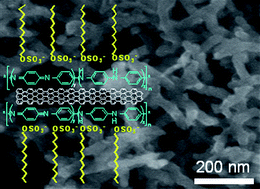Sfez, R. ; Peor, N. ; Yitzchaik, S. Experimental Evidence of Cooperative Effect in a Mixed Parallel and Anti-Parallel Dipoles Monolayer.
Journal of Physical Chemistry C 2010,
114, 20531-20538.
ArticleAbstract
Self-assembled monolayers (SAMs) of polar and polarizable organic molecules are widely used to tune semiconductors’ electronic properties for various applications. In the case of the dipoles’ arrangement in a dense and ordered SAM, intermolecular interaction between neighboring dipoles arises, inducing a change in the electrostatic properties of the polar SAM. These intermolecular long-range dipole interactions give rise to a molecular cooperative effect (MCE) through the layer, thus influencing the magnitude of the net surface dipole and suppressing the substrate contribution to dipole formation. Molecular engineering of the desired MCE could be a useful tool in various molecular electronics derived applications. In this work, we propose an experimental design to tailor the magnitude of the MCE through an organic monolayer. We constructed a mixed dipole monolayer containing parallel and antiparallel randomly organized dipoles. The creation of a mixed dipole monolayer enables controlling the MCE through the layer by giving rise to a smaller normal component to the surface coefficient and larger parallel component to the surface dipole coefficient. A deeper understanding of the MCE can be obtained by comparing the experimental and calculated values of such mixed dipole monolayers. The experimental values were obtained from contact potential difference measurements, and the calculated values were extracted by using the modified Helmholtz equation, based on the relative dipole contribution introduced in this work. This comparison enables analyzing the limit of the expected MCE, based on the evaluated surface dipole density along with its individual longitudinal molecular dipole.
Vaganonva, E. ; Wachtel, E. ; Leitus, G. ; Danovich, D. ; Lesnichin, S. ; Shenderovich, I. G. ; Limbach, H. H. ; Yitzchaik, S. Photoinduced Proton Transfer in a Pyridine Based Polymer Gel.
Journal of Physical Chemistry B 2010,
114, 10728-10733.
ArticleAbstract
We describe an experimental and theoretical consideration of photoexcited proton transfer in a poly(4-vinyl pyridine)/pyridine gel. Evidence was found for two states of a multiple state process analyzed by DFT modeling. According to the latter, following irradiation at 385 nm, the proton donor is the CH group of the polymer main chain and the proton acceptor is the nitrogen of the polymeric pyridine side chain. Proton transfer is made possible through the assistance of a mobile pyridine solvent molecule acting as a transfer vehicle. Proton transfer promotes both a geometrical rearrangement of the vinyl side chain as well as electronic density redistribution. The photoproduct intermediate—the hydrogen-bonded complex between the protonated solvent pyridine molecule and the deprotonated polymeric pyridine side chain—is identified by its Curie law magnetic susceptibility, ESR spectrum, and fluorescence lifetime measurements. The proton transfer from the nitrogen of the solvent pyridine molecule to the pyridine side chain nitrogen, producing pyridinium, is a thermodynamically favorable relaxation process and occurs without an energy barrier. The protonation of nitrogen on the polymeric side chain was detected by solid state NMR spectroscopy performed on a 15N-polymer enriched gel. The calculations and experimental data suggest a central role for the gel solvent molecule as a catalytic agent and proton transfer vehicle. The process suggested by DFT modeling may have relevance for photosensitive devices in part due to the fact that we have been able to show that long-lived paramagnetism may be included among the inducible properties of soft polymer gels.
Ben-Valid, S. ; Dumortier, H. ; Sfez, R. ; Decossas, M. ; Bianco, A. ; Yitzchaik, S. Polyaniline-Coated Single-Walled Carbon Nanotubes: Synthesis, Characterization and Impact on Primary Immune Cells.
Journal of Materials Chemistry 2010,
20, 2408-2417.
ArticleAbstractFunctionalized carbon nanotubes are increasingly exploited as innovative components for the development of advanced biomedical devices. In this study we report a novel synthetic route for the formation of single-walled carbon nanotube (SWCNT)–polyaniline (PANI) hybrids by in situchemical polymerization. The surfactant sodium dodecylsulfate (SDS) is used as a template for monomer assembly and polymerization. The resulting composite preserves the surfactant and is characterized by a tight binding between SWCNTs and PANI. Having the idea of integrating these new types of SWCNT conjugates into advanced biomedical tools (i.e. implantable multi-electrode arrays), we explored their potential impact on the viability and function of cells from the immune system. We have compared the cytotoxic effects of SWCNT-COOH, SWCNT/SDS andSWCNT/SDS/PANI on mouse spleen cells and macrophages. The results indicate that biocompatibility of the different SWCNT conjugates is dependent both on the doses used and the type of cells.

Ben-Valid, S. ; Botka, B. ; Kamaras, K. ; Zeng, A. ; Yitzchaik, S. Spectroscopic and Electrochemical Study of Hybrid Materials of Conducting Polymers and Carbon Nanotubes.
Carbon 2010,
48, 2773-2781.
Article AbstractWe report the preparation and characterization of hybrid materials from conducting polymers and single walled carbon nanotubes. Electrochemical polymerization yields nanotubes wrapped by conducting polymers – polyaniline, polycarbazole and melanin (i.e., polydopamine). The materials were characterized by ultraviolet–visible–near infrared, infrared, Raman and impedance spectroscopy. We found that wrapping the nanotubes with polymers can decrease the impedance of such composite electrode and increase the rate of electron transfer from the electrolyte to the electrode. From the attenuation of in-plane vibrations in the infrared spectra and the bathochromically shifted polaron band, we infer that the strongest interaction occurs between polyaniline and the nanotube surface.
